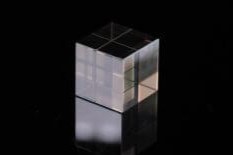Beamsplitters are vital optical components in countless systems—from high-end scientific instruments to everyday imaging devices. Whether you’re designing an interferometer, fluorescence system, or beam combining setup, selecting the right beamsplitter is essential for optimal performance.
This Beamsplitters Selection Guide outlines the core types of beamsplitters, explains how they work, and provides practical advice for choosing the best one for your application.
A beamsplitter is an optical device designed to divide a beam of light into two separate paths—one transmitted and one reflected. This is usually done by applying a thin-film coating on a glass substrate and angling the element relative to the incoming light. In many systems, beamsplitters can also combine two beams into one.

A partial reflective coating determines the reflection-to-transmission (R/T) ratio, such as 50:50, 70:30, or 60:40. This method is commonly used for general-purpose beam division.
Dichroic mirrors reflect specific wavelengths and transmit others.
These are ideal for applications like fluorescence microscopy or thermal management.
This guide summarizes the major form factors and their respective pros and cons.
| Type | Description | Advantages | Limitations |
| Plate Beamsplitters | Flat coated optical substrates | Easy integration, low cost | Beam offset, ghost reflection |
| Cube Beamsplitters | Bonded right-angle prisms | No transmitted beam offset, durable | Higher cost, size restrictions |
| Polarizing Beamsplitters | Dielectric coating on cube or plate | Clean polarization separation | Cube preferred for broadband |
| Non-Polarizing Beamsplitters | Dielectric or hybrid coatings | Maintains polarization | Metallic coatings add absorption |
| Dichroic Mirrors | Thin-film coated plates or cubes | Sharp spectral filtering | Cube design widens transition band |
| Transmission Gratings & Polka Dots | Specialized patterned coatings | Useful for spectroscopy | Less common in standard systems |
Beamsplitters play an important role in many optical systems:
| Application | Beamsplitter Function |
| Interferometry | Splits light to measure interference (e.g., Michelson interferometer) |
| Fluorescence Imaging | Dichroic mirrors separate excitation and emission light |
| Machine Vision | Enables coaxial illumination using plate beamsplitters |
| Sensor Protection | Cold mirrors block thermal IR to protect detectors |
| Lighting Design | Dichroic filters adjust color temperature in illumination systems |
When selecting a beamsplitter, consider these key factors:
Are you combining beams, dividing intensity, or separating wavelengths? This defines the starting point for your selection.
Match the beamsplitter’s coating and substrate to your operational wavelength range—UV, visible, NIR, or IR.
Choose based on how much light you want reflected vs. transmitted (e.g., 50:50 for equal splitting, 90:10 for diagnostics).
Determine if polarization must be preserved, separated, or controlled.
Shanghai Optics offers a wide selection of optical beamsplitters, including:
From biomedical optics to aerospace imaging, our team will help you select or develop the optimal beamsplitter for your exact application.
Contact Shanghai Optics today for more information or to place your initial order.